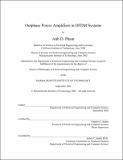| dc.contributor.advisor | Charles G. Sodini. | en_US |
| dc.contributor.author | Phạm, Anh D., 1974- | en_US |
| dc.contributor.other | Massachusetts Institute of Technology. Dept. of Electrical Engineering and Computer Science. | en_US |
| dc.date.accessioned | 2007-01-10T15:34:12Z | |
| dc.date.available | 2007-01-10T15:34:12Z | |
| dc.date.copyright | 2005 | en_US |
| dc.date.issued | 2006 | en_US |
| dc.identifier.uri | http://hdl.handle.net/1721.1/35285 | |
| dc.description | Thesis (Ph. D.)--Massachusetts Institute of Technology, Dept. of Electrical Engineering and Computer Science, February 2006. | en_US |
| dc.description | This electronic version was submitted by the student author. The certified thesis is available in the Institute Archives and Special Collections. | en_US |
| dc.description | Includes bibliographical references (leaves 93-95). | en_US |
| dc.description.abstract | A trade-off between linearity and efficiency exists in conventional power amplifiers. The outphase amplifying concept overcomes this trade-off by enabling the use of high efficiency, non-linear power amplifiers for linear amplification. An amplitude modulated signal is first decomposed into two constant amplitude, phase modulated signals that can be amplified using two high efficiency switching power amplifiers. The two outputs are then recombined to restore the original amplitude modulated signal. In this manner, an outphase power amplifier can simultaneously achieve high efficiency and good linearity. This thesis investigates the capability of the outphase amplifying technique in modern wireless communication. First, a digital amplitude-to-phase conversion scheme is proposed to facilitate the outphase decomposition. By taking advantage of the available computational power in current digital technology, the amplitude-to-phase conversion can be implemented with both accuracy and efficiency in the digital domain. A proof-of-concept outphase power amplifier is fabricated using the IBM 7WL SiGe BiCMOS process technology. | en_US |
| dc.description.abstract | (cont.) The test chip includes two class-E power amplifiers and the first 5.8GHz fully integrated Wilkinson power combiner. The low-loss integrated combiner allows efficient outphase recombining while providing the necessary input isolation for a robust outphase power amplifier. The outphase power amplifier achieves an efficiency of 47% at the maximum output power of 18.5 dBm. For an input Orthogonal Frequency Division Multiplexing (OFDM) signal of 32 sub-channels of 64-QAM, the adjacent channel power leakage ratio (ACPR) is better than 32dBc. The outphase power amplifier's error vector magnitude (EVM) is better than -25dB for up to 20dB of output dynamic range.102 Massachusetts Institute of Technology. Dept. of Electrical Engineering and Computer Science. | en_US |
| dc.description.statementofresponsibility | by Anh D. Pham. | en_US |
| dc.format.extent | 95 leaves | en_US |
| dc.format.extent | 6070448 bytes | |
| dc.format.extent | 6075404 bytes | |
| dc.format.mimetype | application/pdf | |
| dc.format.mimetype | application/pdf | |
| dc.language.iso | eng | en_US |
| dc.publisher | Massachusetts Institute of Technology | en_US |
| dc.rights | M.I.T. theses are protected by copyright. They may be viewed from this source for any purpose, but reproduction or distribution in any format is prohibited without written permission. See provided URL for inquiries about permission. | en_US |
| dc.rights.uri | http://dspace.mit.edu/handle/1721.1/7582 | |
| dc.subject | Electrical Engineering and Computer Science. | en_US |
| dc.title | Outphase power amplifiers in OFDM systems | en_US |
| dc.title.alternative | Outphase power amplifiers in Orthogonal Frequency Division Multiplexing systems | en_US |
| dc.type | Thesis | en_US |
| dc.description.degree | Ph.D. | en_US |
| dc.contributor.department | Massachusetts Institute of Technology. Department of Electrical Engineering and Computer Science | |
| dc.identifier.oclc | 72669361 | en_US |
